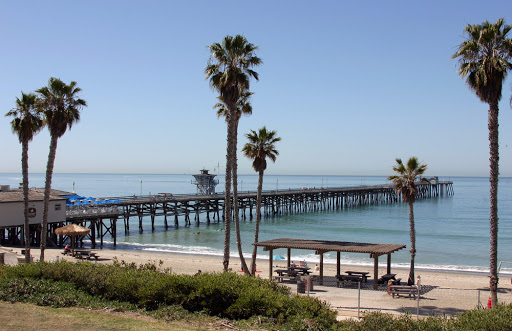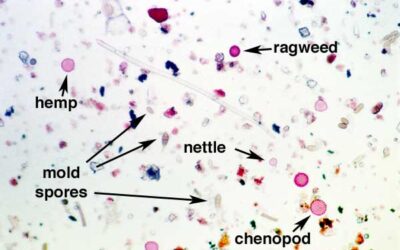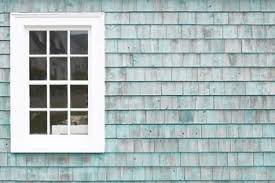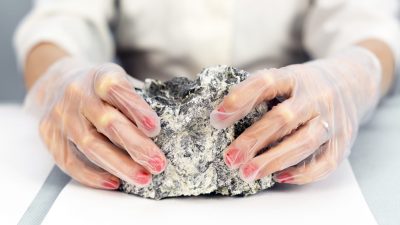Types of Respirators
This is a video about the different types of respirators that workers might use in their workplace. If your employer requires you to wear a respirator on the job, the federal Occupational Safety and Health Administration – also called “OSHA” – and State OSHA Agencies require that your employer select an appropriate respirator for you.
A brief overview and general information about various types of respirators and some of your employer’s responsibilities under OSHA’s Respiratory Protection Standard will be discussed in this video.
This video can be part of the OSHA-required respiratory protection training, which includes many topics, like how to put on and take off a respirator and how to use, clean, and maintain your respirator. Your employer must also provide you with worksite-specific training.
There are two main types of respirators:
air-purifying respirators, which use filters, cartridges, or canisters to remove contaminants from the air you breathe,
and
atmosphere-supplying respirators, which provide you with clean air from an uncontaminated source.
Respirators can also be classified as tight-fitting or loose-fitting.
Tight-fitting respirators need a tight seal between the respirator and the face and/or neck of the respirator user in order to work properly. If the respirator’s seal leaks, contaminated air will be pulled into the facepiece and can be breathed in. Therefore, anything that interferes with the respirator seal is not permitted when using this type of respirator. This could include facial hair, earrings, head scarves, wigs, and facial piercings.
If you are required to use a tight-fitting respirator at work, you must be fit tested with the respirator selected for your use. Fit testing is done to be sure that the respirator’s facepiece fits your face. You must be fit tested before you use your respirator for the first time. You must also be re-tested at least every 12 months to be sure that your respirator continues to fit your face.
A fit test should not be confused with a user seal check. A user seal check is a quick check performed by the wearer each time the respirator is put on. It determines if the respirator is properly seated to the face or needs to be readjusted.
Loose-fitting respirators do not depend on a tight seal with the face to provide protection. Therefore, they do not need to be fit tested.
Your employer is responsible for selecting appropriate respirators to protect you from airborne hazards. To ensure that the correct respirator is selected, your employer must consider a number of factors.
First, your employer must identify and evaluate the hazard.
Your respirator will need different types of filters, cartridges, or canisters depending on the type and amount of airborne contaminant in your workplace. It is your employer’s responsibility to determine which filter, cartridge, or canister is necessary and how often it needs to be changed. For example, respirators that have particulate filters will not protect you against gases, vapors and the non-particulate components of fumes, mists, fogs, smoke and sprays.
Your employer must also determine if the work atmosphere lacks sufficient oxygen, that is, if it is oxygen-deficient, or is contaminated to the point of being immediately dangerous to life or health. This is also referred to as “IDLH.” Only atmosphere-supplying respirators, such as an airline respirator or a self-contained breathing apparatus – also known as an SCBA – can be used in IDLH atmospheres.
Once your employer has identified the type and amount of airborne contaminant present in your workplace, your employer will use this information to see how much protection you need the respirator to provide to you.
Different types of respirators offer different levels of protection. The measure of a respirator’s protection capability is called the Assigned Protection Factor or APF. This is a number that OSHA has assigned to each class of respirators. It represents the level of protection from airborne exposure each class of respirators is expected to provide. The larger the number, the greater the level of protection. For example, when used properly, a respirator with an APF of 10 will reduce your exposure to 1/10th the concentration of the contaminant in the air. Similarly, a respirator with an APF of 50 will reduce your exposure to 1/50th the concentration of the contaminant in the air. OSHA’s APFs can be found in Table 1 of its Respiratory Protection Standard.
When selecting an appropriate respirator, your employer must also consider whether the hazard has any additional characteristics that may affect the type of respirator selected. For example, does the hazard irritate the eyes? Do you need splash and spray protection as well as eye protection? If so, you will need a full facepiece respirator or some type of eye protection.
Let’s take a closer look at the different types of respirators that are available to protect you.
There are advantages and disadvantages to each type of respirator, so it’s important that your employer select the type that’s best suited for your work setting and the hazards you face.
These are filtering facepiece half-mask respirators, sometimes referred to as N95s. A filtering facepiece respirator covers the nose and mouth, and is a tight-fitting, air-purifying respirator in which the whole facepiece functions as the filter. Filtering facepieces may or may not have an exhalation valve to help exhaled breath exit the facepiece. They need to be fit tested, unless you are wearing them under voluntary use conditions. Filtering facepiece respirators filter out particles and do not protect against non-particulate hazards such as gases or vapors.
This is a half-facepiece elastomeric respirator. It is a tight-fitting, air-purifying respirator with replaceable filters (for particulates) or cartridges or canisters (for gases and vapors). In either case, these are attached to a rubber or silicone facepiece that covers the nose and mouth. This type of respirator needs to be fit tested and can be used instead of a filtering facepiece respirator.
An elastomeric half-facepiece respirator can be cleaned, decontaminated, and reused. This is not the case for a filtering facepiece respirator, which is normally discarded after use.
Like filtering facepieces, half-facepiece elastomeric respirators can be used for particulates, but they can also be used for many gases and vapors if equipped with the proper cartridges.
This is a full facepiece elastomeric respirator. This type of respirator provides a higher level of protection than a half-facepiece respirator because it has better sealing characteristics. Since it covers the user’s eyes and face, it can also be used to protect against liquid splashes and irritating vapors.
Like the half-mask elastomeric respirator, this respirator is a tight-fitting, air-purifying respirator with replaceable filters or cartridges attached to a rubber or silicone facepiece. It needs to be fit tested.
This is a loose-fitting facepiece powered air-purifying respirator, or PAPR. A PAPR has a blower that pulls air through attached filters. The blower then pushes the filtered air into the facepiece, which covers all of the user’s face. Since it is loose-fitting, it does not need to be fit tested and can be used by workers with facial hair.
Another type of PAPR is the tight-fitting full facepiece PAPR. This PAPR has an elastomeric facepiece made of rubber or silicone. It has filters and a blower that operate as they do on a loose-fitting facepiece PAPR. Because this PAPR has a tight-fitting facepiece, it must be fit tested.
There are also half-mask PAPRs as well as PAPRs that have a helmet or hood.
This is an airline respirator. It supplies clean breathing air to either a hood or a facepiece through a long hose, from a source of clean air such as a cylinder or compressor. If the facepiece is tight-fitting, it must be fit tested.
This is a self-contained breathing apparatus, or SCBA. It is a type of atmosphere-supplying respirator. SCBAs have a tight-fitting, elastomeric facepiece that covers the user’s face. The air is supplied from a cylinder of compressed breathing air that is designed to be carried by the respirator user. The facepiece is tight-fitting and must be fit tested. As its name implies, this respirator is truly self-contained. These respirators provide the highest level of respiratory protection.
You may hear someone refer to a respirator as an “N95” or a “P100.” While most people use the term “N95” to refer to filtering facepiece respirators, “N95” actually describes the type of filter material and its protective properties. The filter material can be used in either a filtering facepiece respirator or in a filter cartridge that’s attached to an elastomeric respirator.
The first part of the filter’s classification uses the letters N, R, or P to indicate the filter’s ability to function when exposed to oils.
“N” means Not resistant to oil;
“R” means somewhat Resistant to oil; and
“P” means strongly resistant to oil, or oil-Proof.
This rating is only important in work settings where oils may be present, because some oils can reduce the effectiveness of the filter.
The second part of the classification — the number– refers to the filter’s ability to remove the most-penetrating particle size during “worst case” testing.
Filters that remove at least 95 percent of these particles are given a 95 rating. Those that filter out at least 99 percent receive a 99 rating, and those that filter out at least 99.97 percent – essentially 100 percent – receive a 100 rating.
Using this classification method, an N95 filter is not resistant to oil and removes at least 95 percent of the most-penetrating particles.
If you use a PAPR, the high efficiency particulate air filter, or HEPA filter that is attached to your unit, is similar to a P100 filter.
The National Institute for Occupational Safety and Health, or NIOSH, tests different respirator models in its laboratory to make sure they meet certain minimum performance standards. To become “NIOSH-certified,” respirators must pass the performance tests listed in NIOSH’s regulations. For example, NIOSH tests the filter efficiency of the filter materials used in a respirator.
When respiratory protection is required, employers must provide NIOSH-certified respirators to their workers. To see if your respirator is NIOSH-certified, look for the NIOSH logo as well as the test and certification approval number, or TC number. The logo and TC number can be found on the respirator’s package or the user instruction insert, and sometimes they appear directly on respirator components, such as the respirator filter or cartridge. If your respirator is not NIOSH-certified, do not use it in a hazardous area.
You must never alter your respirator. Doing so can reduce its protective quality and expose you to the airborne hazard.
Never glue or staple things to your respirator; do not write on your respirator’s filter material; and never put holes in your respirator.
However, it is OK to write your name on your respirator’s straps.
You must never use unapproved parts on your respirator.
This video has provided you with a brief overview of the types of respirators available and how they are selected to protect you against airborne workplace hazards. There are many other things that you must know and do before you can safely use a respirator in a hazardous work environment. While this video may be part of your respiratory protection training, your employer must also provide you with additional training on respirators, including worksite-specific training.
Remember, if you don’t know if a respirator is needed for the task you will be doing, or if you are unsure about how to properly use a respirator or which filter or cartridge to use, talk to your supervisor before entering the hazardous area.
For more information about respirator use in your workplace, refer to these OSHA and NIOSH websites. You will find OSHA’s Respiratory Protection Standard, additional respirator training videos, and other guidance material to help you work safely.




